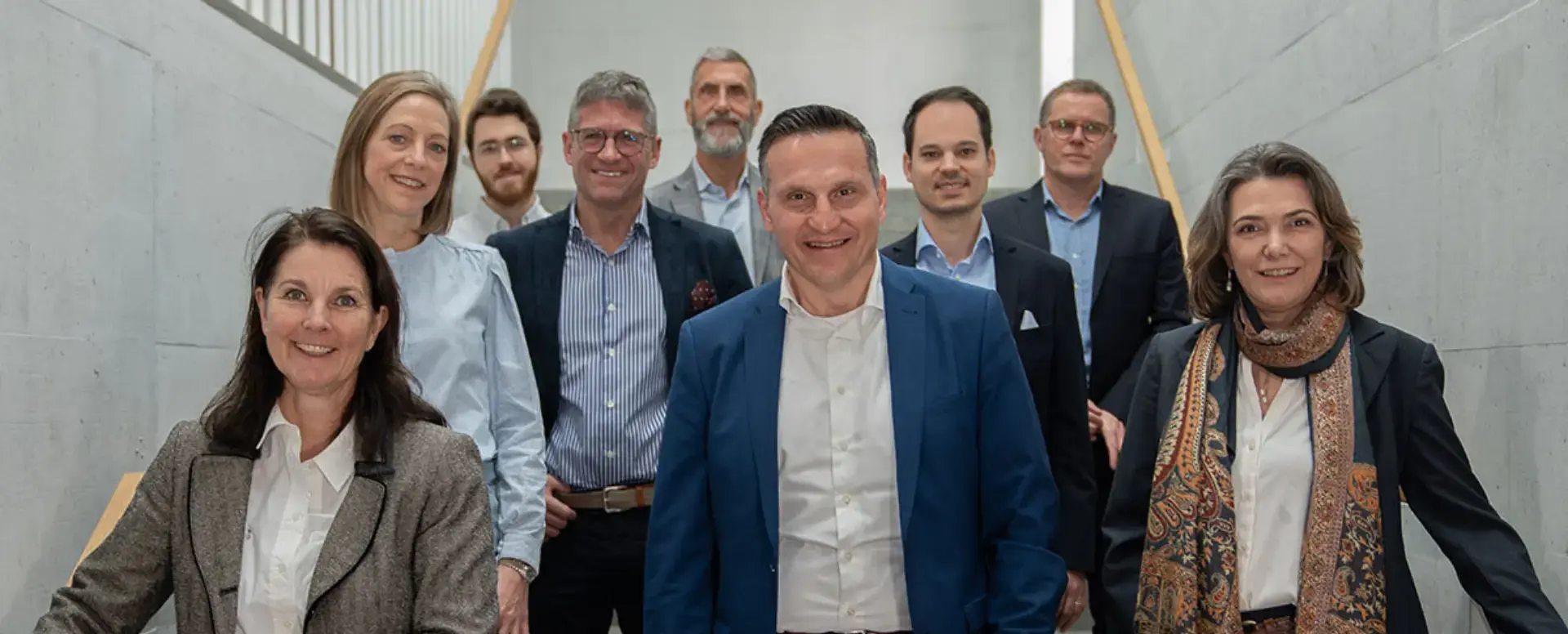How can workforce transformation, a programme typically run by HR teams, help ensure long-term success for organisations and their employees? What role does workforce transformation play in delivering a successful business transformation, and should the C-suite be aligning both strategies from the outset?
Based on a research study released by von Rundstedt Germany, we invited four experts to a LinkedIn Live panel to discuss why the convergence of business and HR strategy is key for long term success.
Our experts shared their key takeaways for business leaders, and we explored whether the insights captured in the report reflect wider trends across Europe.
Download a copy of the report now or read on to discover what our experts had to say.
What is workforce transformation?
Workforce transformation may have different definitions depending on who you’re speaking to, but for Sophia von Rundstedt, author of the study and CEO of von Rundstedt Germany, workforce transformation is part of a long-term strategy.
“It’s not about reacting in a crisis but building a long-term plan to implement future strategy. And that means thinking strategically about what kind of workforce we need in the future to implement the strategy and stay competitive in the marketplace.
“We have to be aware of what future skills we need in our workforce. We have to understand what skills we have today and how big the gaps are. It means having the right people in the right place at the right time to be successful for our businesses.
“We talk about sustainability all the time and to me this has a lot to do with the sustainability of the workforce. If I implement strategic workforce planning, I may not have to lay off anyone because I have enough time to build up the skills that I need. This is very idealistic, but in a nutshell, that’s what it boils down to. It’s sustainability.”
Olivier Landerer, CEO of Global Talent Hub added it’s absolutely about people, but also assessing what skills you have. “Do I have the right skills and the right competencies at the right time as well? It’s looking at the ‘as is’ versus the ‘to be’.”
Michael Moran, Chief Executive of 10Eighty offered a sporting analogy, “There’s a very famous Canadian ice hockey player called Wayne Gretzky. When asked the secret of his success, he said he skated to where the puck is going. This is why it’s a hot topic for organisations because they have got to know where the puck is going. IE what are the future skills they’re going to require? And then how do they get to that place? This isn’t an immediate fix. This is a much longer-term project and it’s quite a high risk because if you don’t get it right, you haven’t got the right skills or your strategy changes and you need a new set of skills, it can be very debilitating for the business.”
“I think the urgency of workforce transformation for CEOs and for companies comes from a demographic perspective, but also simply from an economic perspective,” added Dominic Baumann, Head SME Desk at von Rundstedt Switzerland. “I think companies are realising that it’s just much more expensive to lay off some people and get new people from the labour market.”
Landerer continued, “At Global Talent Hub we see a lot of organisations that are struggling with this topic. The economic situation in a lot of countries is not favourable at the moment and it’s quite difficult. Even if you look at countries that have been growing like China, etc., they’re also struggling now, it’s very competitive.”
Workforce transformation key takeaways for business leaders
#1 It’s an important topic for talent strategy
It’s clear from the German study that HR and the workforce is an important topic for many. 65% of people interviewed said it will increase in importance in the future. That importance seems to stem from inconsistency in talent availability and the impact this has on future planning.
von Rundstedt explained, “In many areas there is a chronic shortage of talent and in some areas, there is an excess. Digitalisation, automation and artificial intelligence reinforce this effect even more. It’s important to note that these things are happening at the same time, and we need to have an honest discussion about what that means for a talent strategy.”
#2 Business transformation and workforce transformation are interdependent
Just over a quarter of respondents said they already look at the interdependence of business transformation and workforce transformation. Although this is a relatively low number, von Rundstedt argued it’s a new approach.
“Rather than the way we did it in the past – defining a strategy and then look at what that means for the workforce, do we need to lay off personnel? – interdependence means that there is an impact both ways.
“If I want to innovate my business model and integrate technology or artificial intelligence, I need different skills and maybe a different type of organisation. This will impact the workforce. On the other hand, if I find people that have rare, future-ready skills, they will have a very positive impact on the innovation of my business model. They will probably challenge my strategy and add new insights. It goes both ways.”
Landerer added, “You hear topics about restructuring, but that’s a very short-term mechanism to be able to save costs. You then see, 6 to 12 months later, that they want to start hiring some of those people or skills back again. But if you invest in your employees today and you look at what you have, you look at where you’re going, you can start looking at how you can develop talents. It’s a whole ecosystem. It’s a very holistic approach that we need to take on this topic that applies not only to Europe, but globally.”
Moran agreed, adding that it is also a mindset shift for employees. “What do most employees do when they think about their career? They look externally as opposed to internally. So both parties have got to change.
“Organisations have got to think much more for the longer term. How do we develop a workforce that’s agile, adaptable and can therefore move with a business strategy. How do we encourage employees that looking internally as opposed to externally is going to help their career?”
#3 Technology won’t fill the talent gap, but it can help manage it
There are plenty of studies that predict a substantial reduction in the European workforce over the next 6 years. Some argue this gap in talent can be filled by advances in technology, particularly AI. But Baumann suggested technology can’t account for the shortfall long-term.
“We often hear people say technology will solve it. There’s enough data showing that technological transformations have led to the disappearance of some jobs. But it has also created other jobs. A recent report from the Mckinsey Global Institute, for example, predicts that just as many jobs will be replaced by technology as will be created. A five-year company strategy will have to take this into account.”
Where technology can add value, however, is with skills based talent management. But, according to Landerer, it must be continually developed. He added, “It needs to live. It’s not something that is static. A lot of organisations have skills mapped in their HR systems, but ultimately, they don’t extract that in an effective manner. The living and breathing of this type of ecosystem is something that’s highly important.”
Solutions to move forward
So, workforce transformation is interdependent with business transformation, and we agree it’s an important topic that technology can’t help us fix. So how do we move forward?
Transformation Units
von Rundstedt offers an example from a recent customer experience. “We are doing a project with a large automotive company, and they need to do layoffs. But at the same time, they have a lot of vacancies they can’t fill. In many cases there’s no transparency – neither for executives that are trying to fill their vacancies, nor for employees who don’t even know what skills they have or skills they could acquire within the next couple of years.
“So, we created what we call a ‘Transformation Unit’ where people whose role will not be existing in the future move into this unit where they can look for opportunities inside the organisation.”
The Transformation Unit approach offers employees the space to ask what opportunities are available and where there is potential for them to develop. Giving this power back to the employee creates much needed transparency – it’s not just about employers offering upskilling and reskilling, but helping people discover learning and development opportunities for themselves.
“It’s about putting people in the driver’s seat of their career,” continued von Rundstedt. “It’s not enough to have a system where you enter all the employees’ skills and then match them with job offerings. Just matching some data, will not convince people to move. They have to understand what’s in it for them, especially when they’ve already seen a lot of things or are in their 50s or early 60s. If people have the right challenge and they’re motivated, they can still contribute to the talent marketplace.
“A corporation here in Germany, founded a new company where people that had already retired, were hired back into this new company to work as a consultant and contribute again. They realised they had lost so much know-how. Sending everybody to retirement at age 57 because you need to do layoffs is, of course, not the solution for the future. This is why we are experimenting with Transformation Units.”
Closer alignment with HR and business leaders
When business and workforce transformation is aligned, it means workforce strategy discussions are not entirely owned by CHROs.
Landerer explained, “What I’ve seen is that HR and CHRO’s don’t always have full power over talent management and talent development – managers, business unit and business leaders are typically involved. So it doesn’t sit in just one camp.”
von Rundstedt added, “We are working on creating more awareness with CEOs around how strategically relevant this issue is and that it’s not just an HR challenge. When you look at the interdependence I mentioned, it’s important for the whole business.”
Moran agreed. “It has become a CEO/Finance driven initiative because, in driving business strategy, you really do need to have a good handle on the resources you’ve got available, both capital and labour.
“The next generation of CEOs in most industries are now all about the IP of people. They’re recognising that people are their most important asset and not something to be easily discarded. Once you make that investment, hopefully in the longer term you can re-skill and redeploy people.
“Good employers acknowledge that a whole series of motivations drive employees and drive engagement, understanding them is critical. Work life balance, making sure it’s a healthy workplace all go along together, so it’s not just looking at skills in isolation. It’s also about looking at what’s important to people, what motivates people.”






